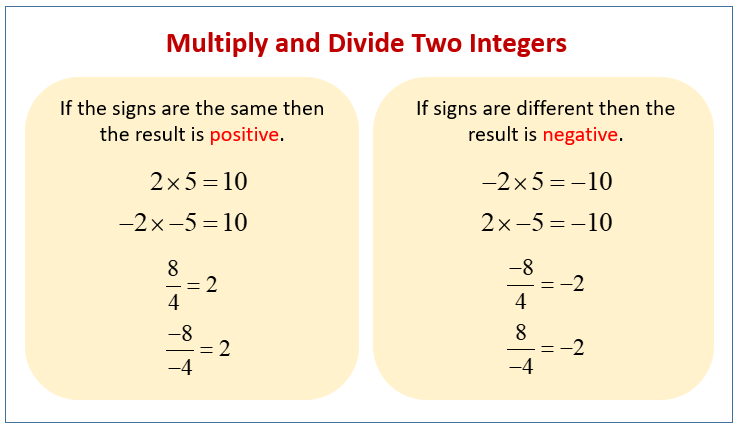Multiplying Integers and Dividing Integers
Related Topics:
More Lessons for Arithmetic
Math Worksheets
Lessons for 7th Grade Math
In these lessons, we will learn how to multiply and divide integers using rules.
The rules for multiply and dividing integers are similar.
The following diagram shows the rule to multiply and divide integers. Scroll down the page for more examples and solutions on multiplying and dividing integers.

Integer Rules Lesson
Check out the following lesson for the integer addition, subtraction, multiplication, and division.
Integer Rules
Integer Worksheets
Practice your integer skills with the following integer worksheets:
Online & Printable Integer Worksheets
Lessons on Integers
Integers and Integer Operations
The Rules for Multiplication of Integers
- Same signs (both positive or both negative) multiply to a positive result.
Example: 3 × 5 = 15, (-2) × (-7) = +14 - Different signs (one positive and one negative) multiply to a negative result.
Example: 4 × (-6) = -24, (-9) × 2 = -18
The Rules for Division of Integers
- Same signs (both positive or both negative) divide to a positive result.
Example: 10 ÷ 2 = 5, (-14) ÷ (-2) = +7 - Different signs (one positive and one negative) divide to a negative result.
Example: 12 ÷ (-4) = -3, (-20) ÷ 5 = -4
Important Considerations for Division:
- Division by zero is undefined in mathematics. You cannot divide any number by zero.
- When dividing integers, the division may not always result in another integer. You might have a remainder. For the purpose of these sign rules, we are generally focusing on cases where the division results in an integer quotient.
What will be the sign for the product when we multiply 2 integers together, for example ( - 2) × (+3)?
When multiplying signed integers, the following rules for signs apply:
(+) × (+) = (+)
(+) × (−) = (−)
(−) × (+) = (−)
(−) × (−) = (+)
Example:
(+2) × (+3) = +6
(+2) × (–3) = –6
(–2) × (+3) = –6
(–2) × (–3) = +6
Recall that any number multiplied by 0 will result in 0.
Example:
4 × 0 = 0
0 × (–103) = 0
Example:
Calculate the following:
a) (–7) × (–2) =
b) 5 × (–3) × (–3) =
c) (–4) × (–3) × (–2) =
Solution:
a) (–7) × (–2) = 14
b) 5 × (–3) × (–3)
= (–15) × (–3)
= 45
c) (–4) × (–3) × (–2)
= 12 × (–2)
= –24
Dividing Integers
When we dividing integers, the similar rules for signs apply:
(+) ÷ (+) = (+)
(+) ÷ (−) = (−)
(−) ÷ (+) = (−)
(−) ÷ (−) = (+)
Example:
(+6) ÷ (+2) = +3
(+6) ÷ (–2) = –3
(–6) ÷ (+2) = –3
(–6) ÷ (–2) = +3
Example:
Calculate the following:
a) (–8) ÷ (–2) =
b) (12) ÷ (–4) =
Solution:
a) (–8) ÷ (–2) = 4
b) (12) ÷ (–4) = –3
Multiply and Divide Integers
Examples of multiplying and dividing negative numbers
Try out our new and fun Fraction Concoction Game.
Add and subtract fractions to make exciting fraction concoctions following a recipe. There are four levels of difficulty: Easy, medium, hard and insane. Practice the basics of fraction addition and subtraction or challenge yourself with the insane level.

We welcome your feedback, comments and questions about this site or page. Please submit your feedback or enquiries via our Feedback page.